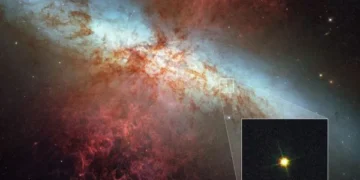In the vast expanse of the universe, where stars are born and die in cataclysmic events, a new kind of explosion has captured the imagination of astronomers and space enthusiasts alike. Dubbed “millinovas,” this recently discovered class of cosmic phenomena lies somewhere between novae and supernovae.
What Are Millinovas?
Millinovas represent a newly identified type of cosmic explosion that bridges the gap between novae and supernovae. Unlike novae, which are relatively faint, or supernovae, which are cataclysmically bright, millinovas shine with a brilliance roughly a thousand times dimmer than supernovae but are still 100 times brighter than the Sun. What sets them apart are their triangle-shaped, symmetrical light curves and the intense X-ray emissions they produce.
This new class of explosions occurs in binary star systems where a white dwarf—a dense stellar remnant—feeds on the material of a swollen companion star. As the white dwarf accumulates this stellar material, conditions are set for these peculiar and less-destructive explosions. Unlike their supernova cousins, millinovas do not obliterate the white dwarf, leaving it intact for further cosmic intrigue.
The Accidental Discovery
The journey to uncover millinovas was as serendipitous as the phenomena themselves. Astronomers from the University of Warsaw, led by Przemek Mróz, were combing through 20 years of data from the Optical Gravitational Lensing Experiment (OGLE). Their original goal? To identify primordial black holes in the Milky Way’s dark matter halo. But the universe had other plans.
Amid the data, the team stumbled upon 28 unusual stellar explosions in the Large and Small Magellanic Clouds. These events were characterized by unique, triangle-shaped light curves that defied the patterns of any known variable stars.
One of these millinovas, designated OGLE-mNOVA-11, erupted in late 2023, allowing scientists to observe it in unprecedented detail. This accidental discovery has since redefined our understanding of stellar explosions.
The Science Behind Millinovas
At the heart of millinovas lies the interaction between white dwarfs and their companion stars. White dwarfs are stellar remnants formed when medium-sized stars, like our Sun, exhaust their nuclear fuel. While solitary white dwarfs remain dormant, those in binary systems can become dynamic and unpredictable. When a companion star expands into a red giant, it fills its Roche lobe, an imaginary figure-eight boundary. This allows material from the companion to flow onto the white dwarf’s surface.
The Explosion Mechanism
The accumulation of stellar material triggers millinovas. While the exact mechanism behind their intense X-ray emissions remains a subject of investigation, two leading theories have emerged:
- Gas Compression and Heating: The gas transferred from the companion star forms a belt around the white dwarf’s equator. This compression heats the gas to extreme temperatures, resulting in the observed X-ray bursts.
- Weak Thermonuclear Reactions: The accreted material on the white dwarf’s surface may ignite weak thermonuclear reactions, producing X-rays without ejecting significant mass. This distinguishes millinovas from the more violent Type Ia supernovae.
The result? Explosions so hot they reach temperatures over 1 million degrees Fahrenheit—three times hotter than the universe’s hottest known stars.
Why Millinovas Matter
Millinovas provide a rare glimpse into the lifecycle of stars, particularly the evolution of white dwarfs and their binary partners. Understanding these explosions could reveal how mass transfer dynamics in binary systems influence stellar behavior.
Progenitors of Type Ia Supernovae
One of the most exciting implications of millinovas is their potential role as precursors to Type Ia supernovae. These supernovae serve as “standard candles” for measuring cosmic distances due to their uniform brightness. If millinovas can predict where and when a Type Ia supernova might occur, they could revolutionize our ability to map the universe.
A New Lens for Cosmic Discovery
Millinovas also challenge existing models of stellar explosions, encouraging scientists to rethink how stars interact and evolve. By studying these events, astronomers can refine their theories about binary systems, X-ray emissions, and the ultimate fate of white dwarfs.
Future Research and Observations
With 28 millinovas identified so far, the race is on to study these cosmic anomalies in greater detail. Researchers plan to monitor these objects in real-time, waiting for their next outbursts. Advanced telescopes like NASA’s Neil Gehrels Swift Observatory and the Southern African Large Telescope are expected to play pivotal roles in follow-up studies.
One of the long-term goals is to uncover the exact conditions that lead to millinovas. Are they exclusive to certain types of binary systems, or could they occur under different circumstances? Scientists also aim to determine whether millinovas consistently evolve into Type Ia supernovae, shedding light on their role in the cosmic ecosystem.
Conclusion
The discovery of millinovas is a testament to the unpredictability of science and the boundless surprises of the universe. These intermediate cosmic explosions not only fill a gap in our understanding of stellar phenomena but also open new avenues for research in astrophysics.
Reference:
Millinovae: A New Class of Transient Supersoft X-Ray Sources without a Classical Nova Eruption



















